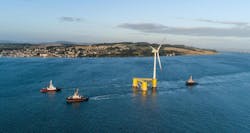Offshore staff
LONDON – A report by the Floating Wind Joint Industry Project suggests the global floating offshore wind industry should grow to 126 MW by the end of 2021, following completion of the Kincardine floating wind farm offshore Scotland.
However, although numerous countries are considering floating wind, the industry faces challenges in maximizing the efficiency of commercial-scale offshore projects, the report cautions. These include:
- Heavy-lift maintenance: commercial floating offshore wind farms are likely to be installed in deeper waters, which are not viable for conventional jackup vessels, and the relative motion of the turbine versus a floating maintenance vessel is a risk that needs to be addressed.
- Tow-to-port: There is a need for better solutions to safely disconnect and store all connections when bringing the turbine back to port.
- Mooring in challenging environments: both very deep and very shallow waters present issued for anchoring of floating offshore wind platforms. These range from selecting the most cost-efficient mooring system, to mitigating the strong dynamic motions of waves in shallower waters.
The Phase-III Summary report outlines the challenges and the solutions that have emerged as part of the projects delivered to date, and a technological competition managed by the Carbon Trust and the Floating Wind JIP.
bp and Tohoku Electric Power have recently joined the JIP, alongside existing members EDF Renouvelables, EnBW, Equinor, Kyuden Mirai Energy, Ocean Winds, Ørsted, Parkwind, RWE, ScottishPower Renewables, Shell, SSE Renewables, TEPCO, TotalEnergies, Vattenfall, and Wpd.
07/13/2021



